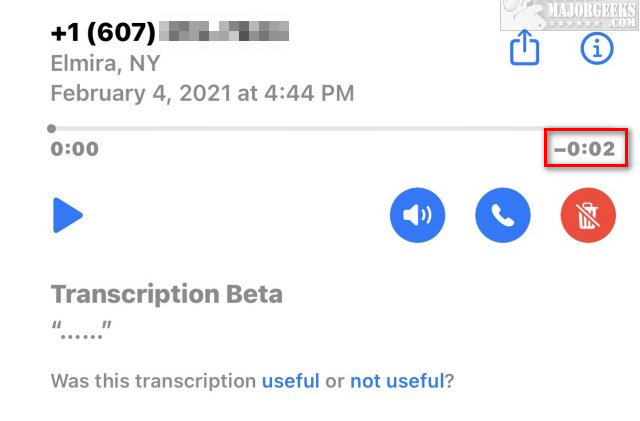What is a 'One Ring' or 'Wangiri' Scam Call?
By Timothy Tibbettson 06/15/2023 |
One Ring or "Wangiri" call scams are making the rounds again and have been going on for decades. Here's all you need to know.
Wangiri is Japanese, where the scam originated, and it means one-ring-and-cut, or in English, one ring and done.
How Did They Get My Number?
Your number most likely was involved in one of the countless data breaches on the internet, and these phone numbers are easy to obtain on the Dark Web, for example.
You can enter your email into ';--have I been pwned?. If your email has been leaked in a data breach, your phone number and more are at risk.
My email is now 21 years old and used widely and publicly, so of course, mine has been leaked.

What Happens If You Answer or Call Back?
If you answer or call back one of these numbers, you can expect to get a large phone bill, similar to calling a 1-900 number. Estimated costs are anywhere from $3-$10 a minute, and it's hard to impossible to get a refund from the phone company. If you don't have an international calling plan, you might also be charged a $20 connection fee. The person calling collects all or a percentage of the money you spend.
Why is this important? We most likely all know someone who thinks it's funny to waste a scammer's time by keeping them on the phone. In this case, the jokes on you, and they'll stay on as long as you want.
Here are some of the ways they try to get you to answer the phone or call back.
They call, let it ring once, then hang up.
They may one-ring your phone multiple times to make it seem urgent.
If you answer the phone on the first ring, you might have a person respond claiming a bad connection and ask you to call them back.
The caller might speak in a very muffled voice for 2-5 seconds to get you to call back.
The caller claims to be from the police, a hospital, or other emergencies and calling them back.
Many times these are robocalls. Here's one I received with a 2-second muffled voice from an area code 30-minutes from my home.

How Can You Protect Yourself?
It's important to note that these calls can come from any number, even your own area code. Spoofers can also use other three-digit area codes from other countries, including the Caribbeans. Most of these area codes include 242, 246, 264, 268, 284, 345, 441, 473, 649, 664, 758, 767, 784, 809, 829, 849, 868, 876 and 869.
Here are some actions you can or can't take to protect yourself.
Never answer a phone number you don't recognize. That's what voicemail is for.
Never call back numbers you don't recognize.
Block outgoing international calls on most devices. Check with your carrier.
Check your phone bill if you think you answered or called back one of these numbers.
If you want to be sure, most smartphones allow you to copy and paste the phone number, so you could also do a Google search for the number.
Similar:
Coronavirus or COVID-19 Scams to Avoid
Your Phone was Hacked Extortion Scam
Extortion Scam Claims to Have Recorded You on Adult Websites
Disney Plus Account Notice Scam
How to Report Online Scams, Spam Emails and More
comments powered by Disqus
Wangiri is Japanese, where the scam originated, and it means one-ring-and-cut, or in English, one ring and done.
How Did They Get My Number?
Your number most likely was involved in one of the countless data breaches on the internet, and these phone numbers are easy to obtain on the Dark Web, for example.
You can enter your email into ';--have I been pwned?. If your email has been leaked in a data breach, your phone number and more are at risk.
My email is now 21 years old and used widely and publicly, so of course, mine has been leaked.

What Happens If You Answer or Call Back?
If you answer or call back one of these numbers, you can expect to get a large phone bill, similar to calling a 1-900 number. Estimated costs are anywhere from $3-$10 a minute, and it's hard to impossible to get a refund from the phone company. If you don't have an international calling plan, you might also be charged a $20 connection fee. The person calling collects all or a percentage of the money you spend.
Why is this important? We most likely all know someone who thinks it's funny to waste a scammer's time by keeping them on the phone. In this case, the jokes on you, and they'll stay on as long as you want.
Here are some of the ways they try to get you to answer the phone or call back.
Many times these are robocalls. Here's one I received with a 2-second muffled voice from an area code 30-minutes from my home.

How Can You Protect Yourself?
It's important to note that these calls can come from any number, even your own area code. Spoofers can also use other three-digit area codes from other countries, including the Caribbeans. Most of these area codes include 242, 246, 264, 268, 284, 345, 441, 473, 649, 664, 758, 767, 784, 809, 829, 849, 868, 876 and 869.
Here are some actions you can or can't take to protect yourself.
Similar:
comments powered by Disqus






